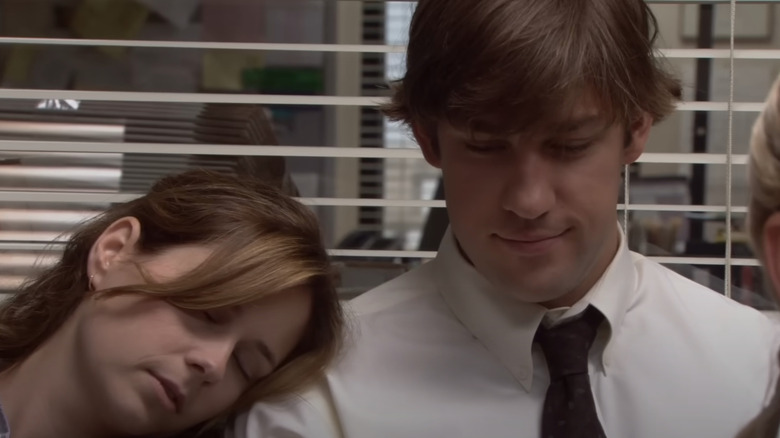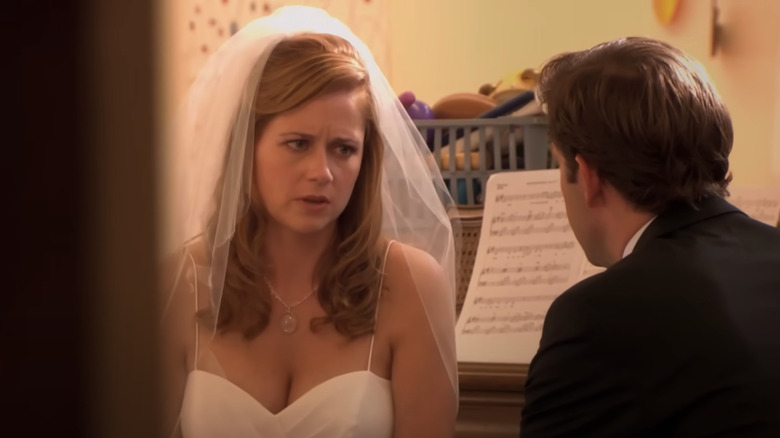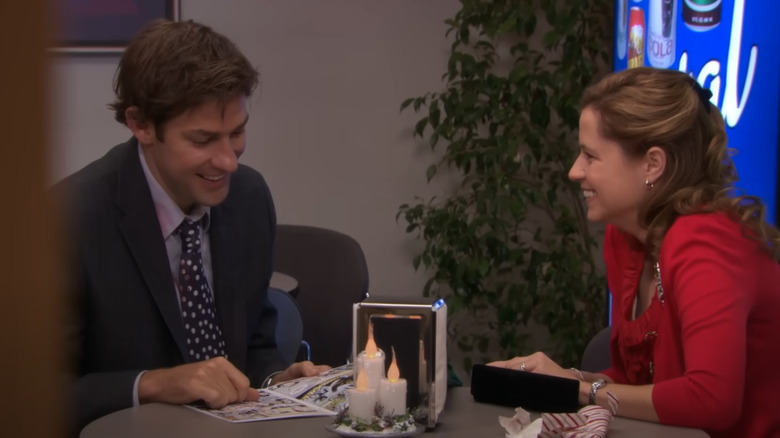The Office Creator Greg Daniels Had One Rule About Jim And Pam's Relationship
In the annals of TV romances, the one between Pam Beesly (Jenna Fischer) and Jim Halpert (John Krasinski) on the U.S. remake of "The Office" looms particularly large, especially among 21st-century examples. Jim and Pam's courtship was, of course, far from the first will-they-won't-they romance featured in a TV comedy. Still, in the modern era, their gradual evolution from being co-workers at the boring Dunder-Mifflin paper company in Scranton, Pennsylvania to becoming married with kids and living happily ever after is quite special.
Indeed, while it's arguable that the show, as a whole, was past its prime by the time "The Office" ended after nine seasons, the Jim and Pam relationship itself remains a high point of the series. It's also set a bar that other TV shows have had to clear when it comes to establishing a believable possible romance (one that causes viewers to swoon and root for a fairy tale love).
Anyone familiar with the original UK iteration of "The Office" knows Jim and Pam had a corollary there with Tim (Martin Freeman) and Dawn (Lucy Davis), another paper salesman and receptionist, respectively. But the British "Office" lasted just 12 episodes across two seasons, as well as a holiday special. The lovelorn duo still lives happily ever after in both cases, but that did mean the U.S. version had to create much of its romance out of whole cloth. How did the series' writers pull it off so well? It turns out that Greg Daniels, who developed and served as a co-showrunner on the U.S. "Office," had a simple rule for Jim and Pam's burgeoning relationship: it wasn't allowed to dominate most of the series' episodes.
Daniels wanted to limit how much time Jim and Pam took up per episode
Where some will-they-won't-they romances in TV history, such as that of Sam Malone (Ted Danson) and Diane Chambers (Shelley Long) on "Cheers" or the dynamic duo played by Bruce Willis and Cybil Shepherd on "Moonlighting," could dominate the entire series, Daniels wanted to be much more cautious in how the writing staff of "The Office" approached Jim and Pam. Daniels, whose past credits included "The Simpsons" and "King of the Hill," is credited with being so cautious by his own cast, as detailed in Entertainment Weekly's 2019 oral history of the season 6 episode "Niagara," which hinges on Jim and Pam's wedding. (Fans of the show know that we see Jim and Pam get married twice in this episode: first, privately on the real-life Maid of the Mist boat that takes passengers directly into Niagara Falls; and second, in an official ceremony with their family, friends, and Dunder-Mifflin co-workers.)
In the oral history, Fischer noted, "Greg had a rule that we would only go to the Jim and Pam relationship maybe once an episode, that it would be rare that we'd spend a whole episode on their love story." Speaking in the same oral history, Daniels himself recalled that the connection between Jim and Pam was so palpable, both through the show's writing as well as the chemistry between Fischer and Krasinski as Pam and Jim, that it drew in plenty of shippers who would breathlessly focus on each minute detail in every installment through the first three seasons (the last of which concluded with Jim finally asking Pam out, and her happily saying yes). That sense of connection is a perfect reason why it made sense for Daniels and the series' other writers to avoid making "The Office" into something akin to "The Jim and Pam Show."
To be sure, moments like Jim's proposal to Pam at a rest stop — which faced unexpected production challenges due to, of all things, 9/11 — or their first serious conversation in the third season after Jim admitted his feelings for her, stand out because of how distinctive they felt. (It's fascinating, though, to consider that the proposal scene inspired an intense debate among the show's production team about how it should even play out onscreen, what with all the rain at the rest stop where Jim pops the question.)
But while many viewers were already on the hook for these two lovebirds to finally admit they feel so passionately for each other, not everyone had that same swooning feeling. Plenty of people watched "The Office" for the antics of the rest of the big ensemble, as opposed to being primarily focused on Jim and Pam's romantic hijinks. And the shippers would likely agree that notable episodes across the first few seasons, in terms of forward or backward movement for Jim and Pam, rarely center entirely on those characters and instead offer something for everyone.
The way The Office handled Jim and Pam early on paid off creatively
It's worth debating whether or not "The Office" always did right by Jim and Pam as characters. Some of the creative choices after the pair tied the knot haven't held up quite as well, such as when one of the boom operators from the in-show fictional documentary consoled Pam after a difficult moment, in part because he'd grown romantically interested in her himself. But part of why those later storylines may fall flat is simply because of how spoiled the audience was in the early seasons when it came to Jim and Pam. The writing staff for "The Office" had done so well, so carefully and patiently building up the relationship between these two, all the highs and lows before they became an official couple, that it was even more triumphant when they finally got together. It's natural enough for TV writers to try and create conflict for even the happiest of couples, but by the time Jim and Pam got married in the sixth season, the audience was so swept up in their romance that they didn't want anything to challenge this happily ever after.
Credit should also be given to Daniels and the show's other writers for being so effective at making Jim and Pam likable and charming, even on the page. Once it became clear that "The Office" would become a longtime staple for NBC, it was inevitable in a sense that Jim and Pam would get together. The manner in which they finally overcame their personal neuroses and peccadilloes only worked, though, because the seasons leading up to them being a real couple hadn't revolved entirely around their growth as characters. If Daniels hadn't made sure his writers were so cautious, it's possible that Jim and Pam may have been more tiresome than endearing. In the end, it was the right move to make the audience want more instead of less.


